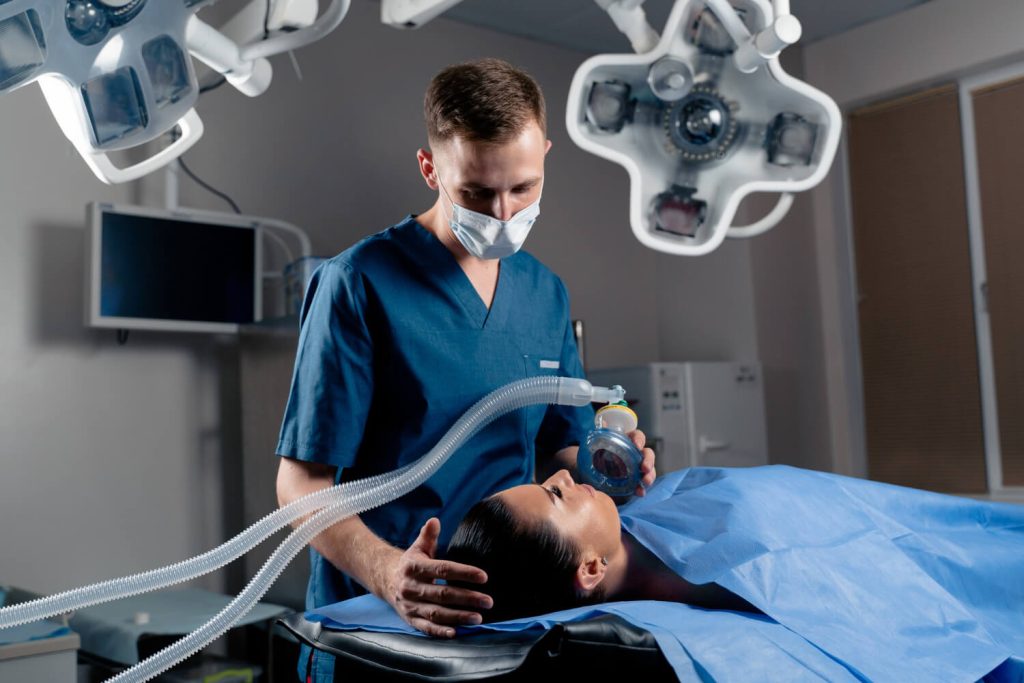Have you ever stopped to think about what really happens when you “go under” during a cosmetic procedure?
The type of sedation chosen can directly influence your surgical experience, recovery time, and even your final results. Many patients focus all their attention on the plastic surgeon, but the anesthesiologist plays an equally important role in the operating room.
Understanding the anesthesia options available allows you to make more informed decisions and feel more confident before your procedure.
Let’s explore how anesthesia in plastic surgery works and what you really need to know.
Why anesthesia is used in plastic surgery
Anesthesia creates the right conditions for the surgeon to perform the procedure with precision and without discomfort for the patient. The type of anesthesia depends on the extent of the surgery, the expected duration, and the patient’s medical history.
For minor procedures, local anesthesia is typically used, while combined surgeries such as a mommy makeover or tummy tuck usually require general anesthesia.
In the United States, protocols follow strict standards established by organizations like the American Society of Plastic Surgeons (ASPS), which defines safety requirements for licensed surgical facilities.
Types of anesthesia in plastic surgery
Each type of anesthesia provides a different level of pain control and consciousness. The anesthesiologist evaluates each patient’s profile before determining the most appropriate method.
1. Local anesthesia
Local anesthesia works by blocking nerve endings in a specific area of the body. You remain completely awake during the procedure, but the treated area becomes fully numb.
Filler injections, minor skin removals, and some limited liposuction treatments can be performed using this technique.
The main advantage? You can drive yourself home after the procedure and resume light activities the same day.
The risks associated with this type of sedation are minimal, usually limited to rare allergic reactions to the medications used.
2. Conscious sedation
Also known as twilight anesthesia, this option places you in a deeply relaxed state. You may respond to simple commands but will likely remember little or nothing after the procedure. This type of sedation combines anti-anxiety medication with local pain relief.
Rhinoplasty, facelifts, and breast augmentation surgeries often use this approach. The American Society of Plastic Surgeons reported that around 40% of cosmetic procedures in 2023 were performed under conscious sedation, reflecting its growing popularity.
3. General anesthesia
During general anesthesia, you become completely unconscious. A breathing tube may be inserted to ensure proper oxygen flow throughout the procedure.
Longer surgeries such as full tummy tucks, combination procedures, or extensive reconstructions typically require this level of sedation.
How do doctors decide which option to use?
The choice of anesthesia in plastic surgery doesn’t happen randomly. Your surgeon and anesthesiologist evaluate several factors before recommending the best option for you.
Factors considered during the evaluation:
- Extent and estimated duration of the procedure
- Your complete medical history
- Medications you take regularly
- Previous experiences with sedation
- Anxiety levels and personal preferences
- Conditions such as sleep apnea or heart problems
Patients with a higher body mass index or a history of respiratory complications may require more intensive monitoring, regardless of the type of sedation chosen. Honesty during the preoperative consultation remains fundamental to ensuring your safety.
What happens at each stage of the process
Before the procedure
You’ll receive specific fasting instructions—typically 8 hours for solid foods and 2 hours for clear liquids. Some medications may need to be temporarily discontinued, especially blood thinners and certain herbal supplements.
The anesthesiologist will review your medical history and explain the anesthesia plan. This is the time to ask questions and share any specific concerns.
During the surgery
Monitors continuously track your vital signs, including heart rate, blood pressure, oxygen saturation, and body temperature. The anesthesiologist constantly adjusts medications as needed to ensure you remain comfortable and stable throughout the procedure.
Modern surgical teams follow strict safety protocols. According to data from the American Society of Anesthesiologists, the rate of serious complications related to sedation in elective surgeries has dropped by more than 60% over the past two decades, thanks to technological advances and improved safety standards.
After the procedure
Recovery from sedation occurs gradually in the post-anesthesia care unit. Nurses monitor you until the effects have sufficiently worn off. Nausea, dry mouth, and drowsiness are common sensations during the first few hours.
If you received conscious or general sedation, you’ll need someone to drive you home. Activities such as driving, operating machinery, or making important decisions should be avoided for at least 24 hours.
Side effects you may experience
Most patients experience some temporary side effects after anesthesia in plastic surgery.
| Side effect | Frequency | Typical duration |
| Nausea | 20–30% | 6–24 hours |
| Dizziness | 40–50% | 12–24 hours |
| Sore throat | 15–25% | 1–2 days |
| Mild confusion | 10–15% | 2–6 hours |
| Chills | 5–10% | 1–3 hours |
Shivering and a sensation of cold are also relatively common, even in heated operating rooms. Your body is readjusting after a period of unconsciousness.
Preparing for a positive experience
Anesthesia in plastic surgery, when administered by qualified professionals in accredited facilities, offers remarkable safety. Proper preparation and open communication with your medical team contribute significantly to a positive outcome.
At Smart Plastic Surgery, our board-certified anesthesiologists work exclusively with cosmetic procedures, bringing specialized expertise to every case. Fully accredited facilities and state-of-the-art equipment ensure the highest safety standards.
Schedule your consultation to discuss your specific anesthesia options. Understanding the process allows you to enter the operating room with confidence, focusing on the transformative results ahead.



